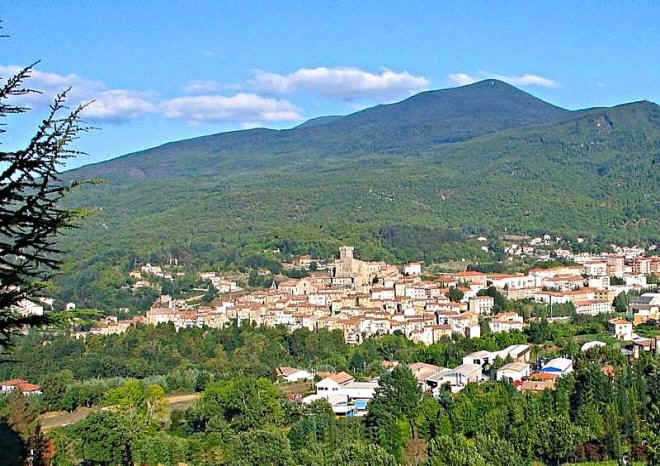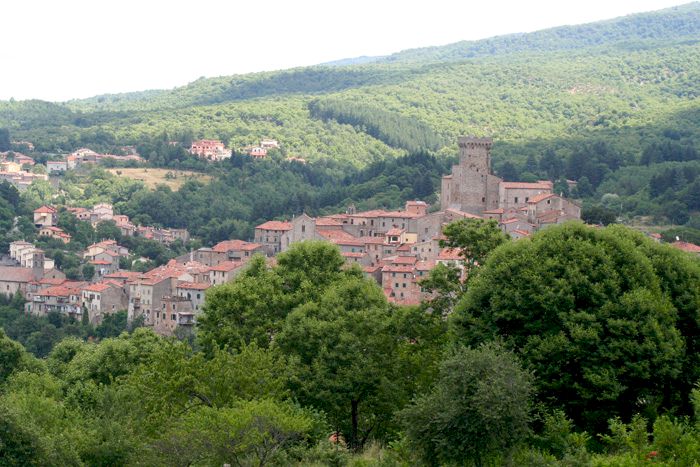|
Arcidosso is an attractive and ancient Tuscan town located at
the foot of Monte Amiata, about 100 km south of Florence, 35 km northeast of Grosseto and near the town of
Montalcino.
Apart from Monte Amiata itself, Arcidosso is famous for its lushly forested
environs. A document dated 860 refers to Arcidosso as belonging to the Abbey of San
Salvatore, but it wasn't until the 19 C that the population of the town began to
grow significantly, and it is now best known as the gateway to the Monte Amiata
Fauna Park.
The historical centre of Arcidosso, one of the most striking among the towns
and villages in the Amiata foothills, is spread along the plateau dominated by the
Fortress of the Aldobrandesca. Three gates from the original mediaeval walls remain, of which two are original – the Porta di Castello and the Porta Talassese towards the sea.
The Porta dell’Orologio was built in 1851 to replace the Porta di Mezzo.
Arcidosso is a useful shopping centre. Here you can find everything you need on a daily
basis: Post Office, banks, small shops, fresh take-away pasta, fresh fruit and vegetables, butcher, bakery, car repair, etc. Just before you enter the village, next to the the first roundabout when you come from Castiglioncello Bandini and Monticello
Amiata, there are Coop and Conad supermarkets.
Main sights of Arcidosso
Church of San Niccoló: the principal building of Arcidosso, it is the oldest
in the town and was established by the Abbey of St. Salvatore and named after the patron saint of the town. Inside there is a precious wooden crucifix and a stoup.
Church of S. Andrea: a splendid Romanesque construction which is custodian of many splendid frescoes, including “La Vergine in Trono” (The Virgin on the Throne).
Church of S. Leonardo: built in the 12 C, it is home to many stunning frescoes
with some architectural elements that were added in the 16 C.
Pieve di Santa Maria ad Lamulas (Parish Church of St. Maria ad Lamulas): a
mediaeval structure, built in the countryside which surrounds Arcidosso. Legend
states that the name of the church is derived from a mythical event, suggesting that one of the walls kneeled down to venerate the Madonna and that it left the imprint of its knee.
Chiesa dell’ Incoronata: built in the second half of the 14 C, this church
commemorates the end of the plague and houses frescoes depicting "La Madonna con il Bambino" and
"La Gloria della Santissima Trinità".
Rocca Aldobrandesca (Aldobrandesca Fortress): a fortress which was constructed in the highest part of the town. Today the building is home to interesting cultural events, shows, conventions and displays.
Fonte del Poggiolo: a splendid marble fountain resembling a small neo-Gothic temple.
The ancient portals that provided access the fortified city: Porta dell’Orologio
(Clock Gate), Porta del Castello (Castle Gate) and Porta Talassese.
Torre di David (Tower of David): a stone monument constructed in near Monte Labbro. It was built for David Lazzeretti, known as “Il Profeta” (The Prophet) in the second half of the
14 C. Today there remains a small church which still receives a great number of pilgrims each year.
The David Lazzereti Study Centre: houses manuscripts, texts and testimonies which tell of the life and the work of the
"Prophet of Amiata".
Visitor Centre of the Monte Amiata Fauna Park (Centro Visite del Parco Faunistico e delle Riserve Naturali):
this well-laid-out centre contains rock ad mineral samples, maps, photos and reproductions
that outline the morphological characteristics of the area, its geographic position and its evolutionary history. You can also
observe the fauna of the park via video monitors.
Annual events at Arcidosso
Monte Amiata olive oil festival held during November in
Montelaterone, a dependency of Arcidosso.
Spring festivals include the Pina festival of the Lamulas parish church (the first Sunday after
Easter), in the Santa Pieve ad Lamulas. This festival has ancient origins, and is related to the engagement
ceremony in which pine and ivy branches and sweets were exchanged.
|


